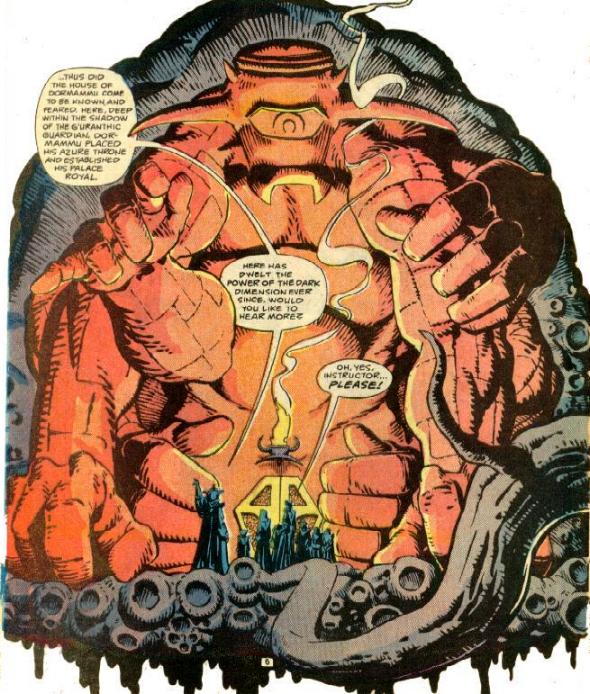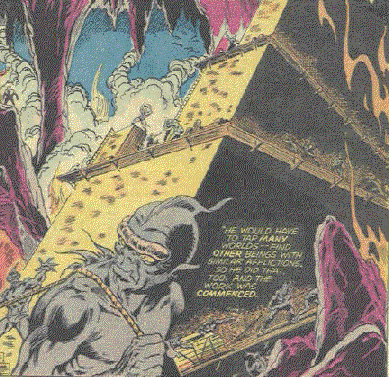In a previous post, I introduced the Dark Salvation event. The key to this is...
The Techno-Demonic Virus Objective Tracker
 |
| I can hear your gasps of awe, really I can. |
Basic Operation
The Tracker works like this. There six Progress tracks on the Tracker: Scientific Understanding, Mystical Understanding, Synthesis!, Technical Details Determined, Occult Considerations Considered, Counter-measure Developed! Each Progress track works like a stress track on a character. If the stress on that track exceeds a D12, then the heroes have achieved that goal in the story. For example, if the Scientific Understanding track is completed, it means at least one of the heroes now understands all that is important, scientifically speaking, about the TDV. The tracks must be completed in the Order shown, and all earlier tracks must be completed before moving on. So, to make Progress on Synthesis!, the heroes must have completed both of the tracks above it.
Progress Rolls
Once per Transition scene, any player, but only one player, MUST make a Progress roll against one of the tracks. This is instead of a recovery roll or creating a resource. That player chooses which track to roll against if there is more than one option available. This roll is opposed by the Doom Pool of their current dimension, that is the dimension where the immediately preceding Action scene took place. This is true even if the transition scene involves moving to a new dimension. The other players may all assist in this roll by providing one relevant die trait from their own character sheets. This will often be a specialty, but could be a distinction or a power if it seems useful given the circumstances of the roll and what has just happened.
Stating Facts about the TDV
If the roll is successful, the player should mark the progress on the Tracker. That player also should state one important fact that has been learned about the TDV, in accordance with the concept of that track. For example, on the Synthesis! track, the fact should have something to do with how the scientific and mystical elements of the TDV are or were combined. This can be anything the player wants it to be, although the player is encouraged to discuss the fact with their fellow players before deciding.
If the roll fails, the Watcher states a fact about the TDV, but no progress is made. The heroes are treading water or have experience a setback, but at least they learned something that might lead them to the next piece of the puzzle.
Some guidelines on facts.
- The fact should, if at all possible, naturally lead to some next destination or activity for the heroes. "The TDV is constructed from dark matter" is a mediocre fact. "The TDV is constructed from dark matter generated at the Arcturus Skrull Research Facility" is a great one. You know where you are headed next.
- The fact should naturally arise from what just happened in the story. Don't stretch for it, or try to link in something totally unrelated.
- On the other hand, feel free to point the fact towards something of interest to you. Always wanted to roleplay in the Microverse? State a fact that brings the Microverse into the story, and you'll probably get your wish.
- If the progress track that was rolled against is not yet complete, the fact should NOT resolve that track in any way. It should be a piece of the puzzle but not the final piece and should leave something unresolved.
- If the progress track IS completed by that roll, then the fact should be the final piece of that particular puzzle pulling together all the previous facts into some kind of harmony.
Write the facts down in the boxes on the right; Insights for the first half of the Tracker, Strategies for the second half, but you'll probably have to expand to the back of the page. In the second half of the Tracker, the facts might be less about knowledge and more about concrete actions the heroes have taken, for example "The sliver of the Crimson Gem of Cytorrak obtained from Hela will be a crucial component of the countermeasure".
The final Synthesis! fact is very important. This should be a summary of all the previous information, putting together all the knowledge created so far, into one, holistic picture of what the TDV is all about. The final Counter-measure Developed! fact is even more critical; it should outline the actual strategy to bring about the end of the TDV's threat to the Marvel Universe.
The Finale
Once that final fact is in place, the heroes now have a game plan and the Event is nearing the finale. Executing the plan may take one Action scene or twenty, depending on how complicated it is and who might be opposing it, and there may not be a guarantee of success, but the heroes now know what they need to do.
The Doom Pool
In Dark Salvation, a new Act starts every time the players travel to a new dimension. As long as they stay in the same dimension, they are in the same Act. The initial value of the Doom Pool is determined by the status on the tracker. In the first phase, it is 4D6, in the second 4D8, and once a counter-measure has been developed, 4D10. If the Watcher is inclined to do so, he/she can track the value of the Doom Pool for a particular dimension, and reset the Doom Pool to that value if the instead of refreshing to the value on the tracker if the heroes return there. This is most relevant for the "real world" dimension, which the players are likely to pass through multiple times before the Event is over.
Notes for the Watcher
Just to reiterate this point,
the player(s) decide on the facts. Not you, or at least not unless they fail the Progress roll. As the Watcher, your job is NOT to figure out what the cause of the TDV is, or how to eradicate it. Your job is to respond to the players as they solve it, and to provide furious opposition to them in the process. You should be just as surprised as they are where the story leads because you are all creating it together in play. You'll know you are doing it right when the players state a fact, and your mind is blown by how that fact is totally unexpected and totally right, exactly the right piece of information to move the story on to the next scene.
This can be tough, don't get me wrong. It will require a lot of improvisation on your part, even with all of the stuff I will posting here in future posts. That's why Dark Salvation is more of a toolkit for an Event than an event itself. Your players could literally end up going ANYWHERE in the Marvel Universe. So, a few pointers...
- Liberally throw plot hooks at your players that point in the direction of dimensions where you actually have prepared some opposition. Throw lots of these, not just one or two, in off hand remarks by other characters and mysterious omens delivered by Odin's ravens and coded transmissions from Kree spies and whatever else strikes your fancy. They'll pick up on some of them, maybe.
- Prepare lots of stuff that won't, in the end, actually be used. Enjoy the process.
- If you have a vision of something you do want to introduce, let your Doom Pool get nice and big, so that you can beat them on the Progress roll and introduce a tidbit of that vision.
- While you'll mostly be reacting, occasionally you should sidetrack the players into something they didn't intend. Lots of powerful entities in the Marvel Universe know something is going on with the TDV, and sometimes they will be proactive in their interference with or assistance to the heroes.
- Don't be afraid to admit to the players you've got nothing for them if they go where they want to go, at least until you have had a chance to prepare for it. Ask them to consider doing something else to close out this session, and you'll have more ready for the next.
- If the players seem unsure where to go next, don't hesitate to throw some nastiness at them to get them moving in some direction, any direction. To paraphrase Raymond Chandler, when in doubt, have a team of Skrull Mystic Commandos come through the door with guns in their hands.


